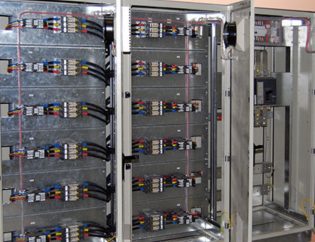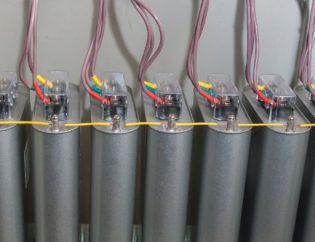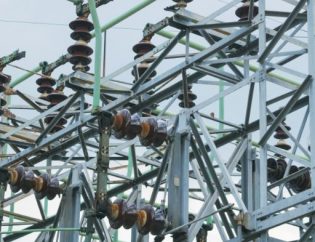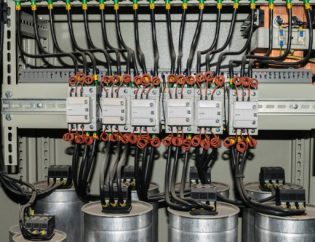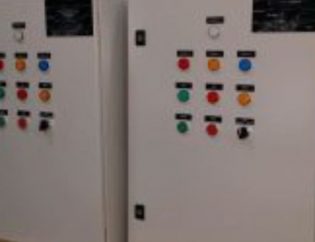Power Factor Improvement Methods:
Various methods are used to improve an electrical system’s power factor. Here are some of the commonly used methods:
Capacitor Banks:
Capacitor banks are one of the simplest and most cost-effective methods for improving the power factor. They are designed to supply reactive power to the electrical system, which helps to reduce the reactive power drawn from the power source. Capacitor banks are available in various sizes and configurations, making them suitable for different types of applications.
Advantages:
- Capacitor banks help to reduce reactive power and improve power factor, which can lead to lower electricity bills and increased energy efficiency.
- By reducing voltage fluctuations, capacitor banks can improve the stability and reliability of the electrical system, reducing the risk of equipment damage and downtime.
- Capacitor banks can help to reduce energy losses in the system by minimizing reactive power, which results in more efficient energy usage and lower operating costs.
Disadvantages:
- Overcompensation can cause overvoltage, which can damage equipment and create a safety hazard. It is important to ensure that the capacitor bank is properly sized and configured to prevent overcompensation.
- Capacitors can fail over time, leading to electrical disturbances and other issues. Regular maintenance and monitoring is required to prevent these failures from occurring.
- Capacitor banks are not suitable for systems with rapidly changing loads, as they may not be able to keep up with the changes in demand. This can limit their usefulness in certain applications, particularly those with variable or unpredictable load profiles.
Types of Capacitor Banks:
- Fixed Capacitor Banks: These are designed to provide a fixed amount of reactive power and are suitable for systems with constant loads.
- Automatic Capacitor Banks: These are designed to adjust the reactive power output based on the system’s load requirements.
Synchronous Motors:
Synchronous motors are used to improve the power factor by providing reactive power to the electrical system. They are connected to the power source and compensate for the reactive power drawn by inductive loads. Synchronous motors are available in different sizes and configurations, making them suitable for various applications.
Advantages:
- Synchronous motors provide a consistent reactive power output, which can help to stabilize the electrical system and improve its overall efficiency.
- By reducing the amount of energy wasted on reactive power, synchronous motors can help to lower energy costs and improve the economic performance of the system.
- Synchronous motors can be used as a backup power source, providing reliable and stable power during emergencies or outages.
Disadvantages:
- Synchronous motors are typically more expensive to purchase and install than other types of motors, which can make them less attractive to some buyers.
- Synchronous motors require regular maintenance to ensure optimal performance and longevity, which can add to the total cost of ownership.
- Synchronous motors are not well-suited for systems with varying loads, as their output may not be able to keep up with changes in demand. This can limit their usefulness in certain applications.
Static Var Compensators (SVCs):
Static Var Compensators (SVCs) improve the power factor by providing reactive power to the electrical system. They are designed to adjust the voltage and current levels in the system to maintain a stable power factor. SVCs are available in different configurations, making them suitable for various applications.
Advantages:
- Static Var Compensators (SVCs) can provide precise and rapid reactive power compensation, which helps to stabilize the electrical system and improve its efficiency.
- By reducing the amount of energy wasted on reactive power, SVCs can help to lower energy costs and improve the economic performance of the system.
- SVCs can be used to mitigate voltage fluctuations, ensuring that the electrical system remains stable and reliable.
Disadvantages:
- SVCs are typically more expensive to purchase and install than other types of reactive power compensation systems, which can make them less attractive to some buyers.
- SVCs require regular maintenance to ensure optimal performance and longevity, which can add to the total cost of ownership.
- SVCs can introduce harmonic distortion into the electrical system, which can affect the performance of other equipment and create additional maintenance requirements.
Active Power Factor Correction (APFC):
Active Power Factor Correction (APFC) is a technique used to improve the power factor by correcting the phase difference between the voltage and current in the electrical system. APFC is achieved by using power electronics to control the power flow in the system. APFC is available in different configurations, making them suitable for various applications.
Advantages:
- Active Power Factor Correction (APFC) can provide precise and efficient power factor correction, helping to optimize the electrical system’s performance.
- By reducing the amount of energy wasted on reactive power, APFC can help to lower energy costs and improve the economic performance of the system.
- APFC can help to improve the overall power quality of the electrical system, reducing the risk of voltage sags, surges, and other issues.
Disadvantages:
- APFC systems are typically more expensive to purchase and install than other types of power factor correction systems, which can make them less attractive to some buyers.
- APFC systems require regular maintenance to ensure optimal performance and longevity, which can add to the total cost of ownership.
- APFC systems can generate electromagnetic interference (EMI), which can affect the performance of other equipment and create additional maintenance requirements. Additionally, they may require additional EMI filtering equipment to be installed.
Types of APFC Techniques:
- Active Harmonic Filter: These are used to eliminate harmonics in the system and improve power quality.
- Resonant APFC: These are used to provide efficient and accurate power factor correction in high-power systems.
- Hybrid APFC: These are a combination of active and passive power factor correction techniques.
Comparison of Methods:
When choosing a power factor improvement method, several factors must be considered, including cost-effectiveness, efficiency, and suitability for different applications.
Cost-effectiveness:
Capacitor banks are the most cost-effective method for improving the power factor, followed by synchronous motors and static var compensators. Active power factor correction is the most expensive method.
Efficiency:
Static var compensators and active power factor correction are the most efficient methods for improving the power factor, followed by synchronous motors and capacitor banks.
Suitability for Different Applications:
The choice of power factor improvement method depends on the type of application. Capacitor banks are suitable for systems with constant loads, while synchronous motors are suitable for systems with fixed power demand. Static var compensators and active power factor correction are ideal for systems with varying and rapidly changing loads.
Conclusion:
Improving the power factor is essential for efficient energy consumption, reduced energy costs, and improved system performance. Capacitor banks, synchronous motors, static VAR compensators, and active power factor correction are commonly used methods for improving the power factor. The choice of power factor improvement method depends on various factors, including cost-effectiveness, efficiency, and suitability for different applications. As technology advances, new power factor improvement methods are being developed to improve system efficiency further.
If you’re unsure which power factor improvement method is suitable for your application, it’s always a good idea to consult with a professional. A trusted electrical care service provider ECSKSA can provide expert advice and solutions tailored to your specific needs.
Do you have a question in your mind? If so, make sure to fill out the form below!

